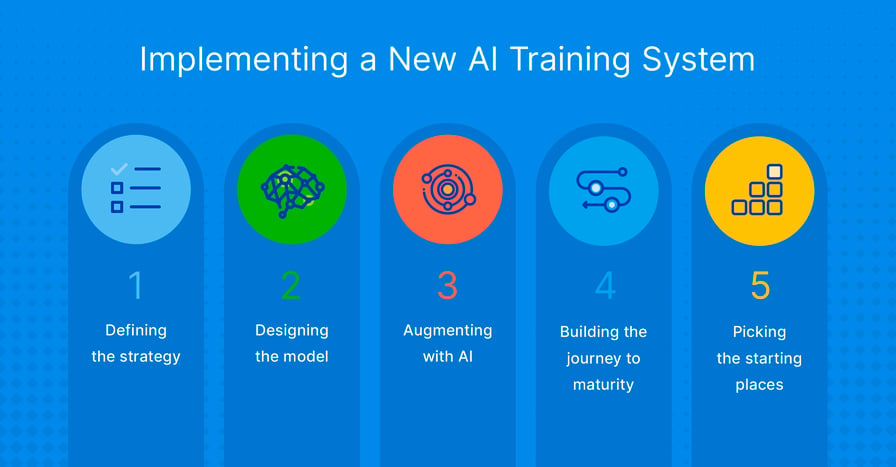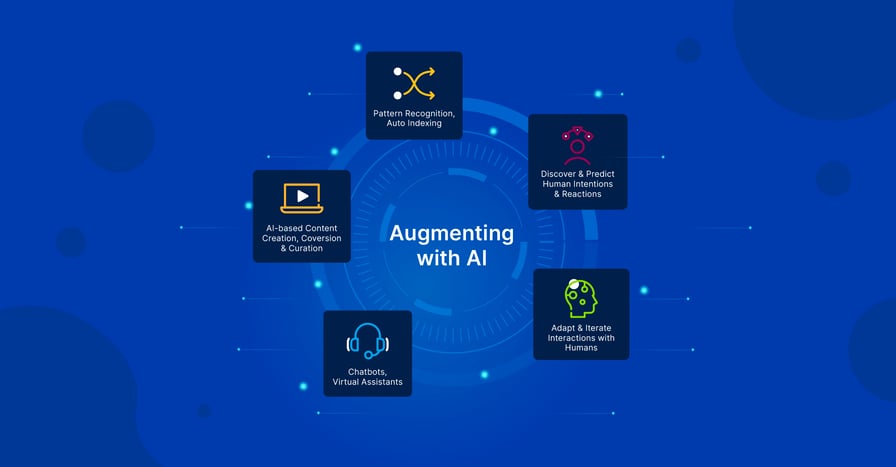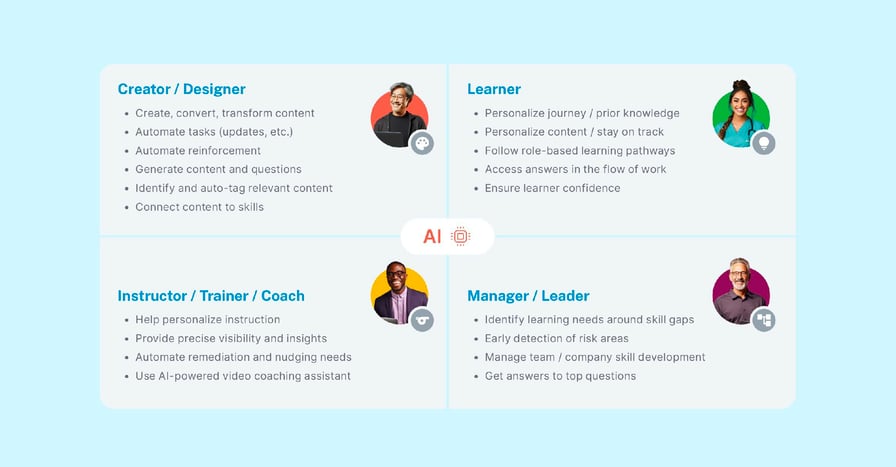Business change is accelerating due to the transformative age we are in, coming out of a pandemic, conducting business in new ways, and leveraging new technologies including the generative AI world hatched by ChatGPT. Agility is the key to successful adaptation. The labor market has seen multiple shifts in the past few years and retaining and developing talent has become more important than ever to success. Firms that have the ability to rapidly train and upskill their workers will be at an advantage in the shifting landscape of modern work.
Traditional learning models, however, lack the flexibility required to do this. They generally follow a one-size-fits-all approach that wastes time and focuses little on bottom line results.
Fortunately, the age of data and the sudden onslaught of AI are upending prior beliefs and processes. Teaching and learning can be reimagined to more effectively address individual learning needs while providing measurable benefits to a company's actual outcomes.
Crafting a Structured 5-Step Approach
Implementing AI into your learning ecosystem can feel like an imperative that you must do something about right away or get left behind. But rather than get caught up in the hype of AI, it is best to slow down and take a structured approach to understanding how to leverage AI in your environment for your learning needs. It requires more than just adopting new technology. It requires rethinking your learning strategy and model.

The entire process of implementing modern personalized learning breaks down into five steps:
Step 1: Defining the Modern Learning Strategy
Defining the right learning strategy that will deliver value for your organization requires adopting an approach around five related factors that collectively lead to an approach that meets the needs of modern learners who have little time for formal learning approaches of the past.
The learning purpose should be performance-aimed and skill-building which means it must be focused on helping people do their job better. This creates value both for learners and for the organization.
Learning delivery should be personalized and available everywhere. Compare this with traditional one-size-fits-all, classroom-based approaches that are redundant and waste the learner’s time.
The learning experience should be continuously adapted. This means constant feedback and adjustment based on AI insights that shape the learning to the learner in each moment.
The learning implementation should be integrated and seamless. Learners should always feel that they are taking part in one continuous learning experience where learning feels like it builds upon itself and the knowledge base is continuous from one course or role to the next.
Learning operations need to become scalable and responsive to business change by leveraging intelligence and automation to meet shifting demands from the business.
Your learning strategy may be slightly different, but you should consider each of these aspects as you define what your essential elements are to build a strategy that fits your organization’s needs for learning.
Step 2: Designing the Right Learning Model
Given a solid foundation with a strategy that you can anchor your decisions upon, the right learning model for modern contexts will have several specific features to carry out the strategy just defined. By incorporating some or most of the following components into your learning model, you will be forming your modern approach that is not just the latest trend in learning technology but delivers real value for the business and the employee.
Individualized learning journeys in the workflow mean that each learner has a tailored, customized journey through the learning materials. Learning must fit the learner's knowledge level and specific job context and be consumable in bite-sized moments when time permits.
Continuously personalizing and adapting training means the technology must understand where learners are struggling and where they are succeeding, and adapt accordingly, not just at the beginning of the course, but at every moment during initial learning and afterwards to reinforce learning.
Evidence-based feedback loops ensure learning is achieved, and to be effective, assessment of knowledge and gathering of evidence must occur throughout the process.
Real-time insights and analytics provide managers and coaches with concrete, actionable information about their employees’ learning performance at a detailed level in the moment so the support they provide can also be personalized and therefore more effective.
AI and automation-enabled for scaling are absolutely necessary attributes to get to this level of personalization at the scale of business.
Additionally, the model should be designed to support all learning moments, connecting all learning needs as you grow your ability to deliver a personalized approach. AI-powered personalized learning can be leveraged in one area and expanded across all areas when you see the need and are ready to expand the modern approach. Typical effective uses include:
Step 3: Augmenting People, Process, and Systems with AI

With a modern strategy and model in place, next it is appropriate to see where AI strategy will play a role in delivering what you want to achieve. AI for AI’s sake is not a good approach, but what AI will do for the human in the loop needs to be the focus. Handing over the reigns to AI to deliver will not be effective, but accelerating all aspects of learning with AI that delivers value for learning stakeholders is a winning approach.
It is best to take a pragmatic approach to putting AI into action in your strategy with the choices you make. Each type of AI has its own best use case. Think of AI as a co-pilot or an assistant for humans. AI best serves to augment intelligence, rather than outright replace it, with different types of AI serving different goals. The following shows the varying role of AI depending on the learning stakeholder’s needs:
 Applying AI to your learning ecosystem will require selecting the right AI tools to deliver the co-pilots that will make the right impact.
Applying AI to your learning ecosystem will require selecting the right AI tools to deliver the co-pilots that will make the right impact.
Step 4: Building the AI Augmentation Journey
Building the AI augmentation journey involves mapping out an AI journey that will take some time for your context. Some organizations are on as much as a five-year journey. One way to formulate your own process is with Gartner's five-level AI maturity model:
-
Level 1: Awareness, is just simple awareness of the possibilities of AI.
-
Level 2: Active, involves AI experimentation, often for data science purposes.
-
Level 3: Operational, involves using AI in production to create value.
-
Level 4: Systemic, involves using AI for business process transformation and creating new business models.
-
Level 5: Transformational, is where AI is an integrated part of a business's DNA. Future decisions are made with AI in mind.
To move through these levels, the first step is to identify and agree on where you are today. Most firms are at early levels in this process.
Getting from awareness to experimentation is a first step. And then having a short-term goal of getting AI operational can lead to realistic and positive results. By operationalizing one or two specific applications of AI, you will get experience that will be extremely valuable to growing your strategy and model in a sound way.
At Level 5, the use of AI is ingrained in how all training at your company operates, and this will take time but may be achievable first in one area such as onboarding.
Step 5: Starting on the Journey
The journey of a thousand miles begins with a single step. The journey of transforming a learning process into an AI-based program begins by applying AI to a single problem.

Because there are diverse problems that AI can solve, there are diverse solutions that your journey may attempt first. Examples across industries including pharmaceuticals, professional services, healthcare, media, and government, as well as across use cases including compliance, product training, upskilling, and onboarding are covered in our recent webinar on taking a modern learning approach to learning. You can watch it here.
Conclusion
Maturity to AI is a journey. You need to rethink your entire learning strategy and model, not just your technology. Look at this process from an impact and value standpoint first—your goal should be to have a measurable impact on your bottom line.
Realizeit modernizes and personalizes learning through the use of modern AI learning technology. We help organizations deploy intelligent, agile, and performance-oriented learning experiences.
Take your first step with Realizeit. Contact us today.